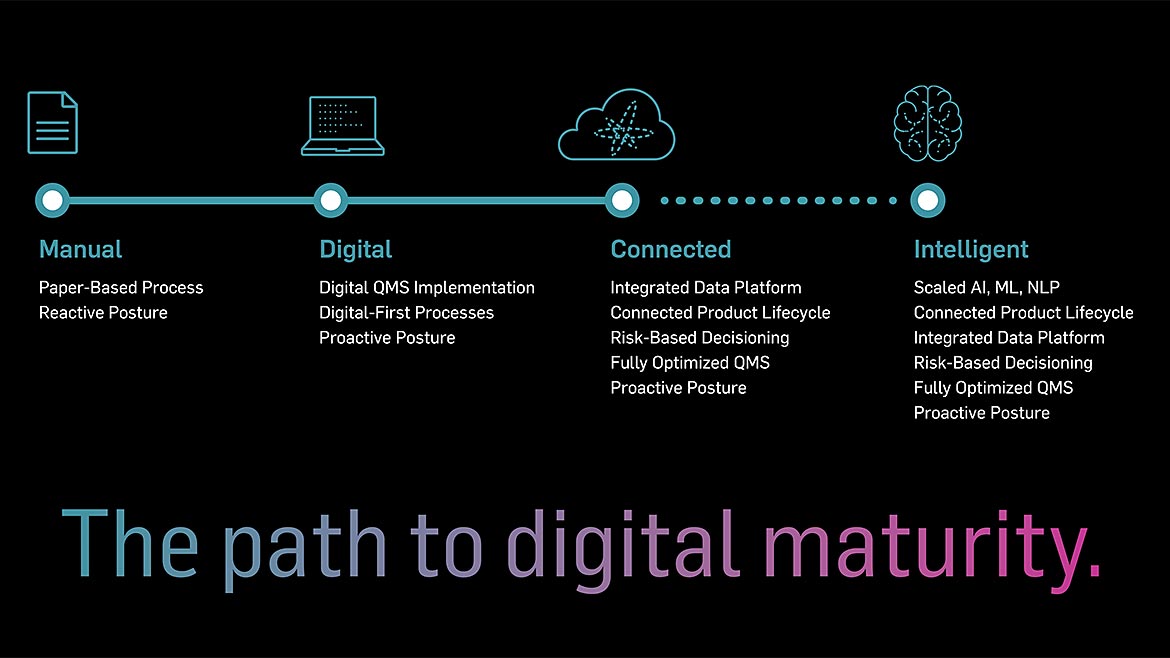According to MasterControl’s 2022 Digital Quality Maturity Study conducted by Cicero research, the majority of quality organizations are going digital, have plans to go digital within the next five years, or believe this is where they need to go to achieve compliance and remain competitive. However, a high number of companies still design quality management systems around manual, paper-based, or hybrid processes which are error-prone, disconnected, and cause delays. Believing that most of their competitors are more digitally mature than they are, and that they need to digitally transform to get ahead, companies still hesitate to implement software solutions.
Regardless of their size, the primary barrier that quality organizations face is the belief that the cost of an advanced quality management system (QMS) outweighs the benefits that come with it. Unfortunately, this is the costliest mistake that companies can make at a time when industry leaders are continuing to invest in software solutions, especially those that support emergent technology, which is a dramatically and rapidly changing industry itself. Pharmaceutical companies, for example, are investing in more patents related to artificial intelligence (AI)[i]and hiring more talent skilled in AI to prepare for, develop, and monitor this technology than any other sector.[ii] Mentions of AI in pharmaceutical company filings increased 105% between 2016 and 2021.[iii]
Companies that delay digitization will pay more down the road and will also be delayed in their ability to leverage intelligent technology. Simply stated, the combined rates of inflation and technology innovation will make it more expensive to acquire and more difficult to implement in the future. By that time, digitally mature competitors will have exponentially outpaced their peers. The latest CNBC Technology Executive Council survey reveals tech leaders consider technology not as a cost center, but rather a business driver – even in downturns.[iv] Further, these companies are actively investing in cloud computing, machine learning and artificial intelligence, and automation. These investments make sense when you consider the cost of poor quality (COPQ). COPQ can increase tenfold for pre-release remediation and jump up to 100 times the original cost of quality for post-release remediation.[v]

The digital maturity spectrum offers a model for innovative quality leaders to measure their current level of digitalization. Once you know where you fall on the spectrum, you can see your pathway to move forward. | Source: MasterControl
Quality personnel need visibility into their system data and processes in order to improve quality and remain compliant. They also need mechanisms to respond to findings in timely and effective ways. Unfortunately, 32% of companies say that manual and paper-based processes continue to pose a very significant challenge to quality management processes. Sixty-one percent of companies claim to be digital, however, they remain unconnected.[vi] This means they are only partially digitized and/or do not work within integrated systems or cloud-based platforms. The pain points remain the same: data is siloed, processes are error-prone, and change is slow.
It can seem overwhelming to consider full digital maturity when you still operate in a manual or hybrid environment. Fortunately, there is a way to take advantage of emergent technology as soon as it becomes available. It starts with digitization. Digital solutions offer proven results that include higher quality products that get to market sooner. An enterprise QMS software solution that allows you to digitize in stages will not only put you on the path, but also give you the provisions and tools you need to take the complete journey.
When it comes to digital maturity, a spectrum can be used to describe where your quality organization currently operates and illuminate the pathway to maturity. At the base of the spectrum an organization is considered manual as long as it continues to use and design paper-based processes. The next stage of development is considered digital as soon as an organization is primarily using electronic records and automated workflows. This stage is the key to ultimately reaching the top of the spectrum. When you are fully mature, your organization can be called intelligent, at which point the system speaks to you, as one quality professional reported.
The added imperative of moving into digitization is that regulatory bodies are also adopting digital solutions and practices. For example, the Knowledge-Aided Assessment and Structure Application (KASA) initiative refined by the U.S. Food and Drug Administration (FDA) earlier this year is an attempt to make pharmaceutical quality-related data more uniform and expedite drug applications. Shifting regulatory environments, equally impacted by technological innovation, are prompting the quality industry to adopt digital solutions and establish a foundation of structured and integrated data practices to remain compliant.
Digitization forms the necessary foundation for any intelligent technology before you can embed it. A training data set with a minimum of two to three years of historical data is critical for any machine learning model to work efficiently and becomes a critical challenge where there is no prior data management or source data available to use.[vii]Intelligent systems are equipped with deep analytical capabilities that can quickly and proactively assist human decision makers to keep a quality system optimized and continuously improving. In the life sciences industries, only 3% of all companies self-assess as intelligent.[viii] There is room for growth – and more importantly, a wide-open field inviting competition.

Technology is a key business driver that enables rapid innovation and differentiation. Implementing advanced quality event management is an important step towards developing an intelligent system. | Source: MasterControl
Preparing to implement and scale AI efficiently requires you to first scale digitization across your organization as well as integrate disparate systems. You can do this effectively using a purpose-built software solution. A QMS system allows customers to capture, see, manage, and leverage their quality data to be more efficient. Based on customer interviews, measurable results include:
- More than 50% reduction in overall quality costs.
- 65% reduction in deviations.
- 90% faster closure times.
- Typical productivity boost between 60% -70%.[ix]
A solution with advanced quality event management (QEM) capabilities allows you to not only mitigate quality events when they occur, but even prevent them before impact. Advanced systems will allow you to design QEM with data-driven architecture that is flexible and adaptable. A unified data lake and advanced analytics and dashboards accelerate improvement.
These solutions are designed with regulatory standards in mind and allow you to integrate compliance directly into quality processes and data as you use them. Consequently, your system is always audit-ready.

Quality professionals that are using advanced quality management software solutions are reaping the benefits of an elegant integration of human and technology resources. Going forward, each resource will continue to enhance the other. | Source: MasterControl
At this point, you can begin to embed AI and optimize your quality system. Identify the most critical areas of the system where you find value. Put it there first and then scale up. With analytical, predictive, and responsive capabilities that extend beyond the limits of unassisted human oversight, your QMS can now be called intelligent. Do you need people? Yes. Along every stage of its development, application, and redirection. These people include data analysts or scientists, engineers and developers, and monitors; but even before you are able to acquire new talent, you can utilize a QMS vendor who is building intelligent technology directly into their platform. No matter what stage you are currently at on the digital maturity spectrum, you can implement a digital QMS, one that supports integration with other quality processes, even manufacturing, and one where AI technology is already embedded within the solution.
AI is code developed by humans for humans to help humans do things in human-like ways. Whew! There are various types of AI that include machine learning and digital twinning. They can be applied for a variety of purposes and in various contexts. For example, an AI-enabled system could predict when an employee might be late to complete a training cycle, or help you predict and assess areas of risk related to using alternate suppliers or materials. Going forward, AI will continue to be used in novel ways. In fact, that is part of the definition of AI: intelligent technology that continually learns from existing data and patterns and changes over time to perform functions more efficiently. The return on any investment in this area compounds over time.
Value lies in a company’s ability to differentiate itself from competitors. In a recent whitepaper issued by the FDA, one of the characteristics of quality maturity, which the agency is promoting to mitigate drug shortages, is to develop a robust quality management system that moves beyond current good manufacturing practices (CGMP) and develop products that can be differentiated by attributes other than price.[x] Use of AI-enabled technology is clearly one of the differentiators on the table. Regulators and business analysts alike affirm that the future of all businesses is going to look very different and those who transform will master the art of AI maturity, using the cloud as the enabler, data as the driver, and AI as the differentiator.[xi] Your tech is unique to you and can be monetized as a proprietary asset. CNBC reports that, “technology is the sustainable differentiator that sets companies apart.” [emphasis added] [xii]

Digitally mature competitors are embracing artificial intelligence (AI) and other emergent technologies to harness their data to make informed business decisions. | Source: MasterControl
So, where will digitization ultimately lead you? To emergent technologies, and specifically AI. But the top of our spectrum is not the end. It is just the beginning. LinkedIn co-founder Reid Hoffman recently stated, “In this environment, we’re competing for making the most and longest-term value for our businesses.”[xiii] Consider his statement in our current context of Industry 4.0, which is characterized by digitization and automation as human-replacements. Then extend it to the Industry 5.0 revolution, which is right on its heels, intending to remedy the dehumanizing aspects of Industry 4.0. There is nothing more valuable than a human life. In the context of quality, pursuing lasting value by achieving digital maturity will lead to an elegant integration of solutions with the people who are using them. It won’t just be about digitization and automation – but about predictivity that makes human work more efficient and less burdensome, as well as enhanced connectivity between humans themselves.
We’re not just talking about long-term financial objectives now. Digital maturity adds a whole new layer of sustainability – directly to human talent that can extend well beyond typical productivity levels. In an unforeseen way, intelligent digital systems designed to accommodate the complexity of human-centric processes and data will actually optimize human talent, allowing humans to continuously yield high-quality products that improve the quality of human life. The benefits apply to both ends of the product life cycle and equally enrich both producer and consumer. How do we know this? Because it’s already happening and companies who fail to undergo digital maturation will not experience these benefits.
References:
[i] “UK: AI In the Pharmaceutical Industry,” Phillip Bennett and David Lang, “Mondaq, April 3, 2021
[ii] "AI hiring levels in the pharmaceutical industry rose in May 2022," Pharmaceutical Technology, June 29, 2022
[iii] "Embracing digitalization in the pharmaceutical supply chain," By Miranda Mclaren, Pharmaceutical Technology, July 25, 2022
[iv] “Despite recession fears, companies aren’t pulling back on technology investments,” By Susan Caminiti, CNBC, July 1, 2022.
[v] “Getting Quality Right the First Time,” Steven Lynn, Susan Schniepp, and Justin Anahory, 2022 Quality Trends, Pharma Manufacturing.
[vi] Supra note 1.
[vii] “The Increasing Use of AI in the Pharmaceutical Industry,” By Kathleen Walch, Forbes.com, December 26, 2020.
[viii] Supra note 1.
[ix] "Digitization, automation, and online testing: Embracing smart quality control," Norman Carra, Evtgeniya Makarova, Jeff Morell, Matthias Ringel, Vanya Telpis, Mckinsey, April 14, 2021.
[x] “Quality Management Maturity: Essential for Stable U.S. Supply Chains of Quality Pharmaceuticals,” Whitepaper CDER, FDA, Current as of July 28, 2022.
[xi] “The art of AI maturity: Advancing from practice to performance,” Accenture, accessed September, 9, 2022.
[xii] Supra note CNBC.
[xiii] Supra note CNBC.



